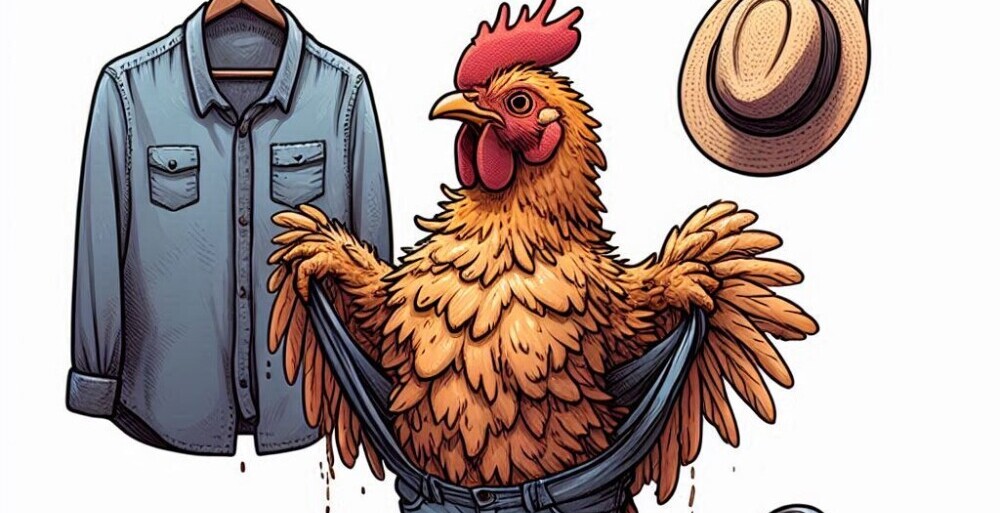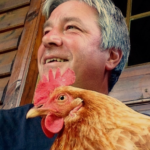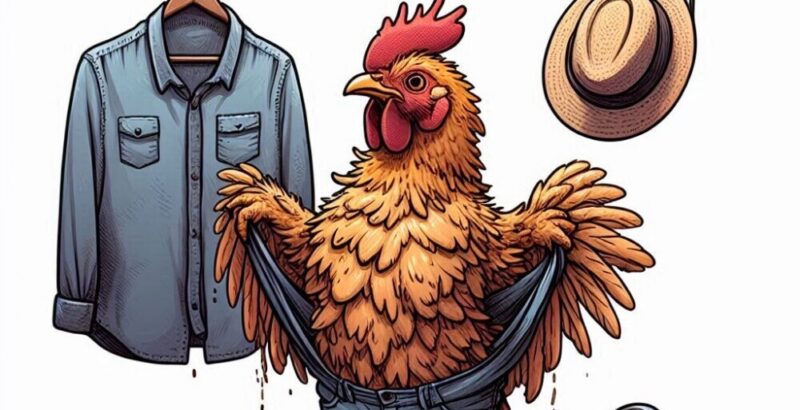
Molting is like a seasonal wardrobe change for chickens. They shed their old feathers to make way for fresh ones, keeping themselves in good shape for whatever the weather might throw their way.
Call it a biological rhythm influenced by day length, temperature shifts, and food availability.
But why do chickens molt in the first place?
It all boils down to their need for a new, better-functioning feather set. This process allows for the replacement of feathers that can become damaged or worn out, helping maintain their insulation and flying ability, even if it’s just a flutter around the coop.
Timing-wise, you might start noticing that your chickens begin their first molt around 18 months of age, although some might surprise you by shedding a little earlier or later.
Molting isn’t only a one-time happening. Typically, chickens molt annually, giving them a fresh look for the new year. The entire process usually concludes within a few months, but be aware that some chickens like to take their sweet time, stretching it to 12-16 weeks.
So, if you’ve got feathered ones looking a little underdressed, it’s quite likely they’re just refreshing their flight suits and not something more worrying.
Timing and Seasonality – When Molting Takes Place
Chickens have their own calendar when it comes to picking the perfect time to molt. Most hens line up their feather-shedding with the arrival of cooler weather, usually kicking off in fall and wrapping up before winter’s deep freeze sets in.
But, here’s the twist—the poultry universe has its share of rebel hens that might molt out of season, even in spring or summer. If the coop’s a little more chaotic than usual, consider unexpected molting as a possibility.
Can chickens molt more than once a year? Occasionally, yes, due to stress or weird weather patterns. But typically, they like to stick to their once-a-year routine.
Each chicken has its style and timing, making it essential to recognize your flock’s molting period and adjust care accordingly. Agitated by abrupt seasonal changes or prolonged high-stress environments, chickens might signal their discontent by altering their molting rhythms.
Don’t worry. You might think you’ll never come to recognize and figure out your chickens’ patterns, but hang out with them long enough, and you’ll discover their patterns and personalities. You’ll discover sweethearts and bullies, shy guys and showboats – huh! Just like people.
Regardless of when it happens, it’s their natural way of prepping to face the outside world with a fresh feather suit and keeping them comfy through every season. Keeping an eye on those seasonal shifts helps in providing the right support during their molting makeover.
Signs and Symptoms of Molting versus Health Issues
Spotting the signs of molting isn’t always a straightforward affair. Chickens lose feathers across their bodies, but it’s particularly noticeable around their neck, back, and butt areas. Picture them strutting around, looking a bit patchy. It’s all part of the transformation!
However, be on the lookout for signs that might point to something other than molting, like illness. While some feather loss is normal, an unhealthy chicken might show symptoms like unusual lethargy, extreme weight loss, or a lack of appetite that goes beyond mild molting discomfort.
If your chicken’s molt seems odd or they’re shedding feathers without regrowth, it could be time to check for underlying issues like stress, nutrition deficiencies, or even parasites sneaking into your coop.
A healthy molt will often follow a pattern, with new pin feathers emerging fairly soon after the old ones drop. If those pins aren’t popping up, it might signal something’s awry. Keep their diet rich in nutrients to help them bounce back with a fresh coat of feathers.
You can check out my Kickin’ Chicken review here if you like. It’s a top-notch all-around supplement that helps keep your chickens healthy and happy (and well-feathered!)
Remember, not every feather fall means trouble, but staying observant ensures that your birds are shedding for the right reasons. Keeping a close watch can ease minds and ensure your feathered companions remain in top form.
Egg Production and Health Considerations During Molting

If you’ve noticed the egg basket looking a little lighter than usual, molting might be the culprit. Chickens tend to put egg production on hold while focusing all their energy and resources on feather regrowth. It’s like their version of a well-deserved vacation from laying.
After their feathers have finished sprouting back, hens usually begin laying eggs again. Depending on the individual bird, this can happen within a few weeks to a couple of months post-molt. It varies from one chicken to another, reflecting their unique feather-shedding rhythm.
Nutritionally, this is a crucial time to ensure your feathery pals get all the right stuff they need. A boost in protein ensures better feather regrowth, making feeds or snacks with higher protein content a welcome treat during this period.
Think about offering them mealworms or even scrambled eggs. Yes, it might seem odd, but these protein-rich goodies help support their feather renewal project. Just remember to keep their overall diet balanced to avoid health hiccups.
Egg production should return to business as usual after molting, with chickens bouncing back to their pre-molt routine in no time. Offering the right support ensures they come through this natural cycle happy, healthy, and ready to fill those egg baskets again.
Behavior, Care, and Management During Molt
When your flock’s molting, moods can get a bit funny. You might notice your chickens acting more lethargic or a tad cranky. Think of it as being in their molting zone, a kind of hibernation-lite, as their bodies channel energy into feather growth.
Despite what it looks like, molting isn’t painful, but it can lead to a little discomfort, which might explain the temporary attitude adjustments. During this time, it’s fairly normal for chickens to be less active or to squabble more often within the flock.
Managing the coop conditions is crucial. Ensure coop lighting supports their natural cycle, and it’s a good idea to check that bedding remains clean and cozy. Molting hens might benefit from quieter spaces to reduce stress, especially if they’re particularly agitated.
Molting is a natural process, and chickens don’t usually need to be separated from their flock unless they’re having serious disputes over bare-backed appearances. However, keeping an eye on interactions helps minimize the stress for everyone involved.
What about the cold or wet weather? Molting chickens are more sensitive to the elements, so ensuring they have a dry, draft-free coop is smart. Some extra TLC with their dietary needs and reducing stressors will make the whole molting season smoother for your feathered friends.
For more info on molting, I have a post called FAQS About Molting in Chickens. Please take a look when you get a chance.
All the best to you and your chickens! Thanks for stopping by, and feel free to drop in anytime.
Dave

Chickenmethod.com

